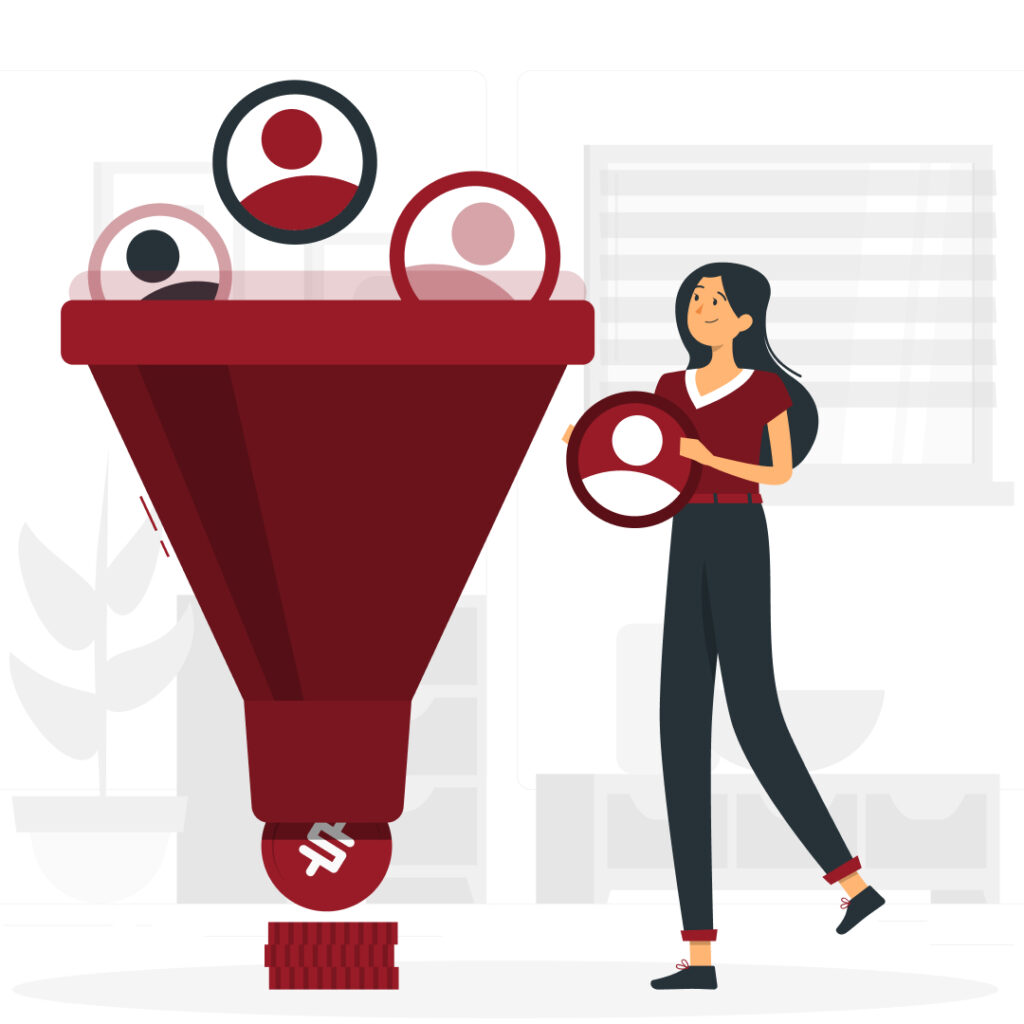Lower funnel marketing is where the marketing rubber meets the road. Effective lower-funnel marketing will propel your digital marketing revenue. But it’s not just about converting your prospects. Powerful lower-funnel marketing that’s designed to deliver the right message when it matters most will propel your revenue in multiple ways.
Why Every Business Should Understand the Lower Funnel
Lower funnel marketing should not be an afterthought. This is when you set the stage for a long-term relationship with potential customers. For a business keen on gaining a competitive edge, understanding this facet of marketing is the difference maker. An effective lower-funnel marketing plan will efficiently convert high-quality prospects into long-term, high-value customers.
Get the Right Customers for the Right Reasons for Long-term Growth

Converting prospects is essential, but retaining them for sustained growth is the crux.
A lower funnel marketing plan ensures you get more of the right customers who genuinely need your offering and will champion your brand in the long run.
The Non-Icky Marketing Funnel
A non-icky marketing funnel should seamlessly guide prospects without making them feel unduly pressured.
Use the Funnel to Support Prospects Throughout their Journey
From the moment a potential customer becomes aware of a brand to when they convert, they’re traversing the marketing funnel. You can trick them into taking the next step or support them throughout this journey with personalized content and interventions. The choice will make all the difference in their ultimate decision and long-term value.
Different Stages of the Marketing Funnel: From Awareness to Conversion

Picture a funnel: broad at the top, narrow at the bottom. In marketing terms, the top represents general brand awareness, the middle is consideration, and the bottom—the coveted lower funnel—is conversion.
However, prospects have a different perspective. The top is when they realize they have a problem and begin their journey. The middle is when they are assessing their options and considering the choices before them. The lower funnel is where they decide.
Businesses can tailor their marketing to support the prospect’s journey by understanding each stage’s nuances. This builds trust and changes the conversion event from a transaction to the next logical step in the prospect’s journey.
Defining Lower Funnel Marketing
Critical Elements of Effective Lower Funnel Tactics
The lower funnel is not a one-size-fits-all endeavor. Effective tactics here hinge on precision, personalization, and timely intervention, ensuring potential consumers don’t drift away at the decision-making threshold.
How Lower Funnel Tactics Differ from Upper and Middle Funnel Tactics
While upper and middle funnel strategies focus on broad outreach and nurturing leads, the lower funnel zeros in on conversion. It’s a laser-focused approach, honing in on consumers poised to make a purchase. Nothing is wrong with any of this, but ‘how’ you convert a prospect is the difference maker.
Understanding Lower Funnel Audience Mindset
These are consumers teetering on the brink of action. They’re informed, have weighed their options, and are looking for that final nudge or affirmation. Give them the tools and resources to make a good decision, and support them, reassure them that they’ve made a great choice.
Recognizing Purchase-Ready Consumers
The Intersection of Intent, Need, and Opportunity—Why Lower Funnel Targeting is Essential for Conversion
Targeting these poised-to-purchase consumers with the right message and offer can spell the difference between a missed opportunity and a successful conversion. Your marketing supports the buyer’s journey. Treating everyone the same and letting them sort out what to do next throws up an obstacle in their path.
Where a consumer’s intent to purchase, genuine need, and the opportune moment meet is the sweet spot for lower funnel marketing success.
Techniques to Master for Better Lower Funnel Marketing
From retargeting to harnessing the power of testimonials, mastering an array of techniques can supercharge your lower funnel efforts.
Retargeting: Re-Engaging Potential Buyers
Personalization: Crafting Tailored Messages for Your Audience
Generic messages are passé. Your prospect is ready to buy. Recognize where they are in their journey and give them content that resonates with their unique needs and preferences.
Using Urgency and Scarcity
Marketers can expedite consumers’ decision-making processes by strategically using the principles of urgency and scarcity. But don’t be fake. False urgency and scarcity are easy to identify. This will damage the trust you’ve built through the funnel.
Leveraging Social Proof: Reviews, Testimonials, and Case Studies
In a world where peer opinions matter immensely, showcasing genuine, relevant reviews and testimonials can provide that final push toward conversion.
Optimizing Content for Lower Funnel Marketing
Crafting content that aligns with the intent, expectations, and questions of lower funnel audiences can significantly up the ante of your marketing efforts. Don’t treat them like they’ve never heard of you before now. Reinforce the reasons why they are at this point and provide content that answers or refutes any questions or obstacles they might have.
Lower Funnel Marketing Channels
Email Marketing at the Lower Funnel: Best Practices
Targeted emails, with compelling CTAs and tailored content, can be potent tools in nudging the consumer toward that final purchase step. Value-oriented messaging at this point will be more effective than the hard sell. Continue to cultivate the relationship. Use social proof to build trust.
Use of Chatbots and AI for Instant Interaction
In an age of instant gratification, chatbots, and AI-driven interactions can provide the immediacy that potential buyers often seek. Being thoughtful about the messaging you use is key. As has been mentioned already, recognize where they are in their journey. Don’t tell them what they already know.
Maximizing ROI with Lower Funnel Marketing
An effective lower funnel strategy doesn’t just boost conversions—it amplifies ROI, ensuring businesses get more bang for their buck.
How does it accomplish this?
By securing the right prospect for the right reason, you will improve your odds that this new loyal customer will remain with you for a long time.
Metrics to Track for Lower Funnel Success
Making Data-Driven Decisions to Improve Execution
It’s true for all marketing, but it’s even more true for lower-funnel marketing; data is king. Use the objective data from A/B Split Testing to decide what’s working and what’s not. Funnel analysis will improve conversion.
Incorporating Feedback to Enhance Lower Funnel Approaches
Consumer feedback is invaluable. It offers a roadmap for continuous improvement and innovation in the lower funnel sphere. Consumer feedback can be overt, they tell you, or covert, you track their behavior on a landing page. But don’t set it and forget it. It’s a game of inches at this point.
Conclusion—The Pivotal Role of Lower Funnel Marketing in Revenue Growth
Lower funnel marketing is not just a strategy—it’s an imperative for revenue growth. A business that recognizes its power will separate itself from the competition. Not only will attention in the lower funnel improve conversion, but by securing the right customers for the right reasons, a business is setting itself up for long-term growth.
Future Predictions: The Evolution of Lower Funnel Marketing Techniques
As technology evolves and consumer behaviors shift, so will lower funnel marketing tactics, but the strategies described in this piece change much more slowly. While forward-thinking businesses must remain agile and ready to pivot and adapt in this ever-evolving landscape, keep sight of the strategy and design your tactics to support the buyer’s journey. Listen to your customers. Support them. They will reward you.
Author: James Hipkin
Since 2010, James Hipkin has built his clients’ businesses with digital marketing. Today, James is passionate about websites and helping the rest of us understand online marketing. His customers value his jargon-free, common-sense approach. “James explains the ins and outs of digital marketing in ways that make sense.”
Use this link to book a meeting time with James.

